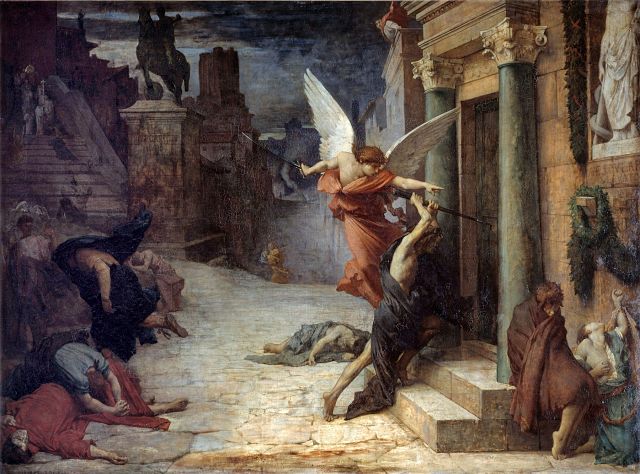 Centuries before coronavirus, plague, smallpox, yellow fever and other contagions killed hundreds of millions around the world. (Photo: In "The Plague in Rome," painted in 1869, artist Jules Elie Delaunay creates an allegorical representation of the scourge breaking down doors/Getty Images)
Centuries before coronavirus, plague, smallpox, yellow fever and other contagions killed hundreds of millions around the world. (Photo: In "The Plague in Rome," painted in 1869, artist Jules Elie Delaunay creates an allegorical representation of the scourge breaking down doors/Getty Images)
The Washington Post
History’s deadliest pandemics, from ancient Rome to modern America
The novel coronavirus has taken just a few months to sweep the globe. How many will die, how societies will change — those questions are impossible to fathom as the disease rages. But history shows that past pandemics have reshaped societies in profound ways. Hundreds of millions of people have died. Empires have fallen. Governments have cracked. Generations have been annihilated. Here is a look at how pandemics have remade the world.
165-180 A.D.
Antonine Plague
Deaths: 5 million • Cause: Measles and smallpox
Many historians trace the fall of the Roman empire back to the Antonine Plague, which swept Rome during the reign of Marcus Aurelius. Nobody has ever nailed down the exact cause, but symptoms recorded by a physician named Galen — gruesome skin sores, high fever, diarrhea and sore throats — strongly suggest it was smallpox and measles. How’d it get there? Armies and tradesman returning from Asia. More than 2,000 people died daily. “The ancient world,” one scholar wrote, “never recovered from the blow inflicted upon it by the plague.”
541-542 A.D.
Plague of Justinian
Deaths: 30-50 million • Source: Rats and fleas
Thought to be the world’s first episode of bubonic plague, its namesake was the Byzantine emperor who was in power when it hit, likely arriving in the form of infected fleas hitching rides across the world on the backs of rodents. Frank M. Snowden, a Yale historian who studies pandemics, wrote in his book “Epidemics and Society” that definitive accounts of this plague have largely vanished. However, diaries from Procopius, a noted historian back then, indicate that many thought the end of civilization was upon them. “A pestilence,” Procopius wrote of the plague, “by which the whole human race was near to being annihilated.” Researchers are still digging up evidence connected to the plague all these years later. “Scientists working in Bavaria in 2005,” Snowden wrote, “identified the plague bacillus in skeletal remains from a sixth-century cemetery at Ascheim, strongly suggesting that the traditional diagnosis of bubonic plague is accurate.”
1347-1352
Black Death
Deaths: 75-200 million • Source: Rats and fleas
History Today, a monthly magazine of historical writing published in London, calls this pandemic “the greatest catastrophe ever.” The number of deaths — 200 million — is just astounding. Put it this way: That would be like wiping out roughly 65 percent of the current U.S. population. (Covid-19 disease modeling predicts U.S. deaths to potentially reach 240,000.) Like the Plague of Justinian, the Black Death was caused by the bubonic plague. The swift spread of the disease continues to astonish historians and epidemiologists. “The central explanation lies within characteristic features of medieval society in a dynamic phase of modernization heralding the transformation from a medieval to early modern European society,” Ole J. Benedictow, a University of Oslo historian, wrote in History Today. Big ships carried goods across ever-widening shipping routes throughout Europe and beyond. “This system for long-distance trade was supplemented by a web of lively short and medium-distance trade that bound together populations all over the Old World,” Benedictow wrote, dubbing this the “golden age of bacteria.”
1520-unknown
New World smallpox
Deaths: 25-55 million • Cause: Variola virus
Explorers arrived to the New World bearing more than just turnips and grapes. They also brought smallpox, measles and other viruses for which New World inhabitants had no immunity. “Although we may never know the exact magnitudes of the depopulation, it is estimated that upwards of 80–95 percent of the Native American population was decimated within the first 100–150 years following 1492,” according to a 2010 paper in the Journal of Economic Perspectives. “Historian and demographer [Noble] David Cook estimates that, in the end, the regions least affected lost 80 percent of their populations; those most affected lost their full populations; and a typical society lost 90 percent of its population.”
—
Related:
Ethiopia Declares State of Emergency, Recruits Health Workers to Fight Virus
Ethiopia Virus Cases Hit 52 (LATEST UPDATE)
WHO Director Slams ‘Racist’ Comments About COVID-19 Vaccine Testing
Ethio-American Tech Company PhantomALERT Offers Free App to Track & Map COVID-19 Outbreak
‘Your Safety is Our Priority’: How Ethiopian Airlines is Navigating the Global Virus Crisis
Inspiring Amharic Poetry: A Reflection by Shimelis Amare (YouTube)
Getting Through COVID 19: ECMAA Shares Resources With Ethiopian Community
Maryland Issues COVID-19 Fact Sheet in Amharic for Ethiopian Community
Art in the Time of Coronavirus: Guide to Virtual Exhibitions from Ethiopia to U.S.
We Need Seismic Change, Right Now: by Marcus Samuelsson
City Sleeps: A Look At The Empty NYC Streets Amid The Virus – In Pictures
Ethiopia enforces 14-day quarantine for all travelers
Diaspora-based Tech Professionals Launch Ethiopia COVID-19 Response Task Force
Amid COVID-19 Pandemic Hopeful & Inspiring Stories Shared by Obama
Pleas to Diaspora to Assist Coronavirus First Responders in Ethiopia
Coronavirus Sparks an Epidemic of People Helping People in Seattle
Join the conversation on Twitter and Facebook.

























